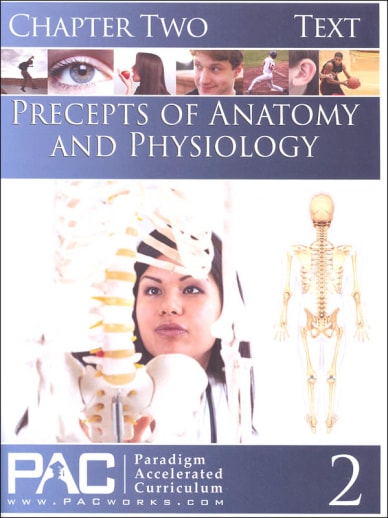- Bargain Items are brand-new products that have been dinged, dented, or scuffed, but are otherwise in usable condition.
- Bargain Items have limited inventory, and they are only reserved for you when checkout is completed.
- Bargain Items are non-returnable and non-refundable.
The Precepts of Anatomy and Physiology (two chapters of text and two companion activity books) can serve as a stand-alone unit study worthy of ½ high school transcript credit in anatomy, or may incorporate chapters 2 and 3 from the Principles, Theories and Precepts of Biology course to create a full credit in A&P (providing those chapters have not been counted for biology credits). Refer to local or state policies for assigning transcript credit for high school science courses.
This two-part unit study introduces high school students to the wonders of the complex design of the human body. Lessons include the structure, function and interaction of body systems, organs, glands and hormones as well as hazards to, and diseases of, various organs and systems.
One of the objectives of this unit study is to equip teenagers with knowledge and principles with which to make positive life choices that will enhance health and happiness. Thus, students learn how life choices, diet, exercise and even thoughts affect physical and emotional health.
The last three lessons of part two deal with male and female reproductive systems, discreetly worded and illustrated by line drawings. The student will learn that life begins at conception. The benefits of traditional roles of husband and wife are discussed. The student will marvel at the intricate and miraculous development of a baby from fertilization to birth: the maturation process of bones, organs, tissues, muscles and joints that compose the wonders of the human body. These three lessons are also applicable as supplemental material for sex education or abstinence studies.
CHAPTER 2 TEXTKey topics: The circulatory systemstructure & function of the heart, blood cells & blood vessels; diseases of the circulatory system; the respiratory systemstructure, function & diseases of; the digestive systemstructure & function, nutrient needs & consequences of deficiencies, the role of the liver; the excretory systemstructure & function of kidneys, importance of water balance, kidney disease; the immune systemprotective role, function of, diseases of, vaccines; reproductive systemmale & female types; menstrual cycle phases; embryonic development; fetal development; birth & lactation


